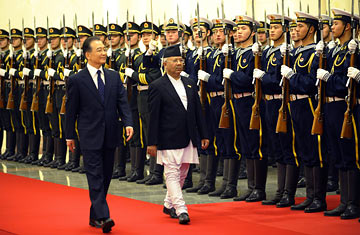
Chinese Prime Minister Wen Jiabao, left, and Nepal's Prime Minister Madhav Kumar Nepal inspect the Chinese People's Liberation Army honor guards during a welcome ceremony at the Great Hall of the People in Beijing
Nepal may be most famous for its majestic Himalayan peaks, but much of the country is a vast stretch of plains, the terai, which have long been underdeveloped and largely ignored by the two powers on either side. No longer. India has just launched a plan to spend $361 million over the next several years on roads and rail links in the terai, announcing the grants just before Nepali President Ram Baran Yadav made his Feb. 15 official visit to New Delhi. China, meanwhile, recently increased its annual aid to Nepal by 50% to about $22 million.
The money is certainly welcome in Nepal, which has the lowest per capita income in South Asia. But the jockeying for influence between China and India may be undermining Nepal's fragile democracy, as the country's 24 political parties trade charges of being pawns of one or the other. Even a tiny royalist party, supporters of Nepal's deposed King Gyanendra, have gotten into the act, staging a rally in Kathmandu on Feb. 22 that shut down the capital for a day. Meanwhile, the parties are debating complex constitutional issues, including a proposed federal system of 14 ethnicity-based states. Nepal's interim constitution will expire on May 28, and if its politicians cannot agree on a new one by then, the constituent assembly will be dissolved, new elections will be called and, many observers fear, the country will enter a period of deep uncertainty. Says Nihar Nayak, a researcher with the New Delhi–based Institute for Defence Studies and Analyses: "They are moving toward a political crisis."
India, for its part, maintains that it has always had a "very deep and vast relationship" with Nepal based on its shared cultural ties. Both countries have a majority Hindu population, and they share millions of cross-border migrant workers. But the character of that relationship has changed. India used to engage Nepal only at the highest levels, in meetings between bureaucrats, ministers and — until Gyanendra stepped down in 2008 — representatives of the King. That has changed dramatically over the last few years, since Nepal's Maoists came to power in a 2006 peace agreement that ended the monarchy, halted a decade-long insurgency and set the country on the road to democracy. The Maoist leader Pushpa Kamal Dahal, known as Prachanda, has cultivated close diplomatic ties with China. In the meantime, India's government changed too: the ruling Congress Party severed its parliamentary alliance with the leftist parties in 2008, resulting in the closing of a key channel of communication to Nepal.
Recent security concerns, however, have given India new reasons to reassert itself in Nepal by investing in infrastructure as well as more troops on the border. Security experts say that that jihadist groups in the region exploit the porous border between India and Nepal, and they worry that India's Maoist insurgency may do the same. "That is their biggest concern," says Nayak.
China's main interest in Nepal has always been led by its concerns over Tibet, which has been ruled by China since 1950. Beijing's involvement with Nepal grew much more intense after the March 2008 ethnic Tibetan uprising against Chinese rule, which deeply embarrassed the Beijing government on the eve of its expensive Olympic Games. There are an estimated 20,000 Tibetans living in Nepal but, with China pushing Nepal to tighten its border with Tibet, the number of new refugees reaching Nepal has dropped to about 500 from an annual figure of around 2,500. But it too has increased its focus on economic ties — trade between China and Nepal has quadrupled since 2003. This week, China said it would restart the tourist bus route between the Tibetan capital Lhasa and Nepal's capital Kathmandu. It had suspended the service in 2006.
The apparent jostling for influence is making Nepal's tricky politics even trickier. By far the most difficult issue left unresolved since the 2006 peace talks is the integration of the former Maoist guerrilla fighters into Nepal's army, a conflict that led to Prachanda's resignation as Prime Minister last year. India's military academies have historically been the training ground for Nepal's top officers — the Nepali army chief graduated from the Indian Military Academy in Dehradun — so the Maoists have long claimed, most famously in a fiery speech by Prachanda in December, that India backs the Nepal army and wants to restore the monarchy. Ironically, the influence of India is the one point on which the former King and the Maoist former Prime Minister agree. When Gyanendra was on the throne, he too chafed at any hint of excessive Indian influence. It may be an inevitable dilemma for a small country squeezed between two giants — and one that Nepal has less than three months to resolve.
